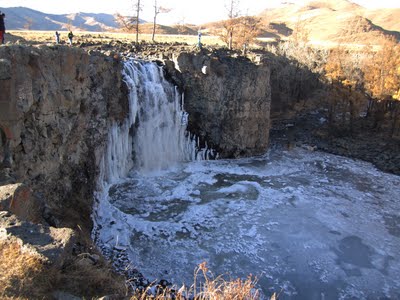Hotel Uralhad a travel agency on the premise and we spoke to the lovely Julia about activities near Perm. She recommended Perm 36 – the only Gulag labor camp still standing in the entire country (the rest have been systemically dismantled and destroyed). But, she went one step farther and hooked us up with her friend Vasil who is fluent in English (he studied in Switzerland for years) and had taken people to site in the past.
Upon meeting Vasil, we knew we’d be in good hands. He was amazing; young, kind, funny, in-tune with America pop-culture and eager to answer our questions and help us understand the area and history.
After two hours of driving, we turned right onto a dirt road and made our way to the entrance of Perm 36. Drab, dilapidated, barb-wire rimmed.
Perm 36 opened in the 1920’s and housed up to 150 prisoners at a time. In 1927 it became the primary USSR camp for political prisons and high ranking military dissidents
Growing up, history was one of my favorite subjects in school, but I was shocked and embarrassed by how little I knew about the Gulag system.
During the 70+ years of the Gulag, there were thousands of labor camps across the country and over 40 million people were imprisoned – that’s every 4th man in Russia, in a Gulag. In some regions there were more Gulag camps than villages.
The system started as a punishment for those who opposed the government, but turned into forced labor at random; the government using everyday citizens essentially as slaves for manufacturing.
Walking into the yard was surreal. It was a pleasant day and the surrounding forest was peaceful, making it difficult to fathom the atrocities that occurred here.
Vasil informed us that this camp was operational until 1986. 1986!?!?! I couldn’t believe it. In my lifetime, there were still prisoners in the Gulags?!
The perimeter of the camp was secured by a system of five fences patrolled by guards and dogs. No one ever escaped from this camp and in fact, no one ever even tried.
Psychological torture was common practice. A security hut separated the work yard from bunk houses and multiple times a day prisoners would enter the hut, be forced to strip naked and be searched. During the winter months the temperature would hover around -30C degrees.
The sole outhouse for prisoners was placed over 100 yards away from any other building, so going to the bathroom in the winter became a literal nightmare.
Intelligent, educated prisoners were forced to preform mundane tasks like stamping out metal hinges. Many lost their minds or killed themselves.
Bunk house floors were intentionally uneven and difficult to walk on and prisoners slept on “bunk beds” – a plank or two of wood. No blankets. No pillows. No heat. I couldn’t wrap my head around how people were able to survive such conditions.
Wives of prisoners were automatically given a five year sentence. Women in the Gulags did everything possible to get pregnant so that they would have one month off work duty before and after the birth. Children born in the Gulag (most died within eight months) were sent to special child labor camps.
One of the most appalling and unreal aspects of the Gulag system is that prisoners were workers and got “paid” with virtual money. They then had to “buy” things, like food and clothes and a plank bed to sleep on – they essentially had to work to “pay” to stay in the camp. Talk about psychological torture.
Some prisoners spent upwards of 30 and 40 years in the camps for things like disagreeing with the government or writing a paper questioning some government practice.
Normal citizens in the area (including Perm) were completely unaware of Perm 36’s existence. Vasil expressed his distress and disgust when he discovered that many everyday things he had used as a child – zippers, a clothing iron – were made by Gulag workers. No one knew.
After spending the day in this haunting place, I couldn’t help but be affected. Decades of forced labor, oppression, psychological torture and abuse at the hands of a government that claimed to have the best interest of the people in mind, is nearly unfathomable.
I came to realize why so many people (particularly the older generations) have the “take what you can, when you can, for yourself” mentality and are cold and unfriendly – they have every reason to be after what they endured.
I can honestly say that there are few places that have resonated so deeply with me. Places like this force you to step back and realize just how privileged we are as Americans and how insignificant our everyday problems really are.
Sidebar – Our guide book had told us that it was possible to take a bus out to Perm 36 and we had considered that option. What the book left out is that there is an insane asylum down the road from the Gulag and the patients are allowed to wander the street at will…maybe something that might be important to know before venturing out to middle of nowhere unattended. It would have been quite concerning had we not been forewarned that people would bang on our car windows and approach us while talking to themselves. Get on that Lonely Planet.
For more Photo Friday head over to Delicious Baby!






I rode the Trans-Siberian RR in 1989. Hard to imagine the camp had only been out of use for 3 years at that time (and was probably NOT a museum yet I’m sure). Found you via Delicious Baby – looking forward to reading more of your posts about Russia, a country that is special to me.
Wow! I’m trying to imagine what the atmosphere of the country would have been like in ’89. Such an amazing route though – glad you got to experience it!
Nice post with excellent pictures. The pictures alone would make me want to go there, because they show how much character the place has!
I would suggest anyone who had visited this web site and/or Perm-36 and who has not read Solzhinsen’s books (especially Gulag Archipellago) to do so.